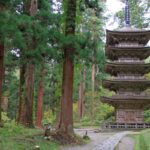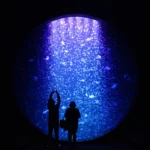
Tucked away in the mountains of Yamagata Prefecture, Ginzan Onsen (銀山温泉) is one of Japan’s most beautiful and nostalgic hot spring towns. Famous for its wooden ryokan (traditional inns) lining both sides of a narrow river and the soft glow of gas lamps that illuminate the town at night, Ginzan Onsen transports visitors straight into the atmosphere of Japan’s early 20th century — or even a scene from a Studio Ghibli film.
Contents
A Town Born from Silver and Steam
The name “Ginzan” literally means “Silver Mountain,” a reference to the Nobesawa Silver Mine, which was discovered in the 16th century. During the Edo period, this mine thrived as one of Japan’s key silver-producing sites. When mining declined in the 18th century, the hot springs discovered nearby gave new life to the area, turning it into a beloved onsen retreat.
The Ginzan River runs through the heart of the town, flanked by beautifully preserved Taishō- and early Shōwa-era wooden inns — giving visitors the sensation of walking through Japan’s past.
Scenic Beauty and Timeless Atmosphere
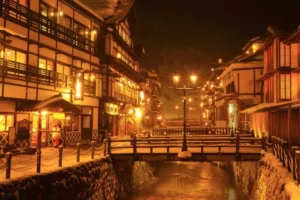
What makes Ginzan Onsen so special is its romantic scenery. During the day, the town’s riverside path is lined with charming bridges, wooden balconies, and flower boxes. But it’s at night when the magic truly happens: as the gas lamps light up, their golden reflections shimmer on the river, creating a breathtakingly nostalgic view.
In winter, Ginzan Onsen becomes a snow-covered fairy tale village — one of the most photographed scenes in Japan. The contrast between the warm glow of the inns and the pure white snow creates an unforgettable experience.
Ryokan and Hot Spring Experience
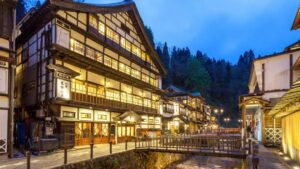
There are about a dozen ryokan (traditional Japanese inns) in Ginzan Onsen, many of which have been in operation for over a century. Each offers natural hot spring baths sourced directly from underground geothermal springs.
Most inns provide both indoor and open-air baths (rotenburo), with soothing, slightly milky hot spring water rich in sodium and sulfur — known for relieving muscle pain and fatigue.
Many ryokan are exclusive to overnight guests, but some offer day-use bathing during the day. One of the most famous is Notoya Ryokan, an architectural masterpiece known for its iconic façade often featured in travel magazines and TV dramas.
Public Baths and Footbaths
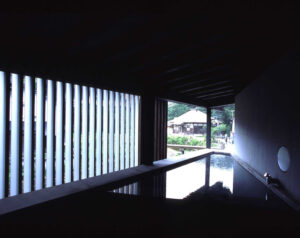
If you’re not staying overnight, you can still enjoy the town’s onsen atmosphere through:
-
Shiroganeyu Public Bath (白銀の湯): A small, clean, and affordable bathhouse open to day visitors.
-
Warashiyu Footbath (和楽足湯): A free public footbath along the river, where you can relax while admiring the historic scenery.
These options make Ginzan Onsen accessible even for those on a day trip.
Seasonal Highlights
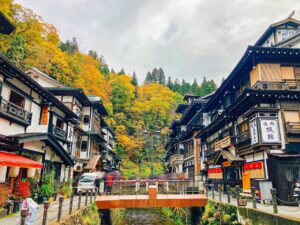
Each season brings a completely different charm to Ginzan Onsen:
-
Spring: Cherry blossoms bloom along the riverside, and the snowmelt gives the town a fresh, lively feel.
-
Summer: Fireflies glow at night, and cool mountain breezes make evening strolls delightful.
-
Autumn: The surrounding mountains burst into vibrant reds and golds.
-
Winter: Heavy snow blankets the entire valley — this is the most iconic season, often compared to scenes from a fairytale.
Local Cuisine
Guests at the ryokan can enjoy kaiseki-style dinners featuring local Yamagata ingredients, such as A5 Yonezawa beef, mountain vegetables, river fish, and seasonal fruits. In the town, you can also find:
-
Hot spring manju (steamed buns)
-
Soba noodles, a regional specialty
-
Cream-filled taiyaki and hot spring eggs sold at local stalls
Nearby Attractions
If you’re staying longer, explore the area around Ginzan Onsen:
-
Shirogane Falls (白銀の滝): A beautiful 22-meter-high waterfall located just a short walk from the town. It’s especially striking in winter when icicles form around it.
-
Nobesawa Silver Mine Ruins: Learn about the area’s mining history by exploring the remains of the old tunnels and equipment.
-
Mount Gassan and Zao Onsen: Both accessible within a few hours, offering more natural scenery and hiking opportunities.
Access
By Train and Bus:
-
From Tokyo, take the Yamagata Shinkansen to Oishida Station (about 3 hours).
-
From Oishida Station, take a local bus bound for Ginzan Onsen (approx. 35–40 minutes).
-
Buses operate several times daily, but check schedules in advance as service is limited, especially in winter.
By Car:
-
About 40 minutes from Oishida Station or 90 minutes from Yamagata City.
-
Parking is available outside the town, as the central streets are pedestrian-only.
Practical Information
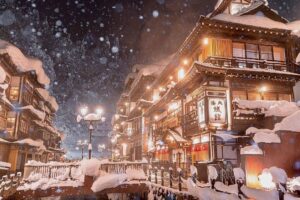
-
Location: Ginzan Onsen, Obanazawa City, Yamagata Prefecture
-
Best Time to Visit: Winter (December–February) for snow scenery; autumn for colors
-
Accommodation: Limited; advance reservation recommended, often months ahead in peak season
-
Language: Basic English spoken at some inns; translation apps are helpful
-
Wi-Fi: Available in most ryokan, though coverage may be limited outdoors
A Journey into Japan’s Timeless Charm
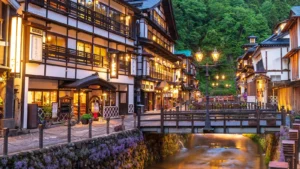
Ginzan Onsen is more than just a hot spring destination — it’s a living museum of Taishō romanticism, where visitors can feel the spirit of old Japan through architecture, atmosphere, and hospitality. The blend of history, nature, and tranquility makes it one of Japan’s most photogenic and unforgettable onsen towns.
As the steam rises from the riverside baths and the lamps flicker in the evening snow, you’ll understand why Ginzan Onsen continues to captivate travelers from around the world — a place where time slows down and the beauty of Japan’s past quietly comes alive.
Related articles
Accommodation sites
Agoda
